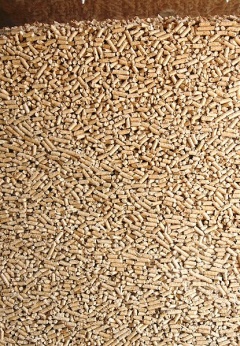Corn gluten pellets
| Infobox on Corn gluten pellets | |
|---|---|
| Example of Corn gluten pellets |  |
| Facts | |
| Origin | This table shows only a selection of the most important countries of origin and should not be thought of as exhaustive
|
| Stowage factor (in m3/t) | - |
| Angle of repose | - |
| Humidity / moisture |
|
| Oil content | 0.15 - 0.9% |
| Ventilation | Recommended ventilation conditions: surface ventilation. As with bulk cargoes of expeller, pellets are also often not ventilated; see also text. |
| Risk factors | Corn gluten pellets are liable to the risk of self-heating/spontaneous combustion. |
Corn gluten pellets
Contents
Description
Corn gluten pellets are obtained from gluten feed (residues from starch production from wheat and corn, such as husks and gluten particles) by adding a suitable binder (e.g. 1 - 3% of molasses, fat or colloidal clays) and then pressing the composition under high pressure in pelletizing machines or extruders to form cylindrically shaped pellets. A distinction is drawn between expeller pellets and extraction meal pellets depending on their origin.
Corn gluten pellets are brown to beige in color and crumble easily as they have a fines content of approx. 20%. The pellets are approx. 50 mm in length.
Applications
Rich in protein, these pellets are primarily used as poultry, swine, and cattle feed. Corn gluten feed provides a high energy, low fat food source that is highly digestible and rich in crucial amino acids.
Shipment / storage
Corn gluten pellets are chiefly shipped in bulk and the stowage spaces should allow mechanical ventilation. The product is not to be stowed near/over heat sources (i.e. fuel tanks, hot pipework, engine-room bulkhead etc.)
The travel temperature should preferably be between 5 and 25°C. Temperatures of up to 30°C are admissible for short periods, providing the critical water content of the product is not exceeded - in order to avoid self-heating -.
Product temperatures of 25 - 55°C may occur in tropical ports; if en-route the temperatures are rising >55°C and increasing further, closing of hatch openings and injection of CO2 or inert gas should be considered.
At temperatures of 35 - 40°C within the stow, fat degradation and thus self-heating is activated.
Seawater, rain and condensation water are damaging to the product, since moisture encourages mold, mustiness and self-heating.
Surface ventilation is recommended. However, to avoid moisture damage on the surface of the cargo, ventilation must not be performed with cold external air. The ventilation system must then be switched to return air. As with bulk cargoes of expeller, pellets are also often not ventilated.
An increase in CO2 and CO content in the hold air is indicative of a vigorous heating process resp. fire in the cargo. CO2 has a smothering action on the seat of the fire because it displaces oxygen.
Note:
See also advice on overseas shipment of Seedcake
Risk factors
- Self-heating / Spontaneous combustion
- Odor
- Contamination
- Toxicity / Hazards to health
- Shrinkage / Shortage
- Insect infestation / Diseases











